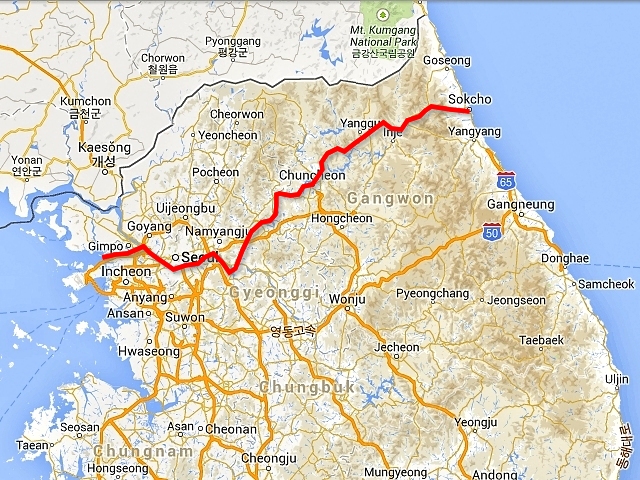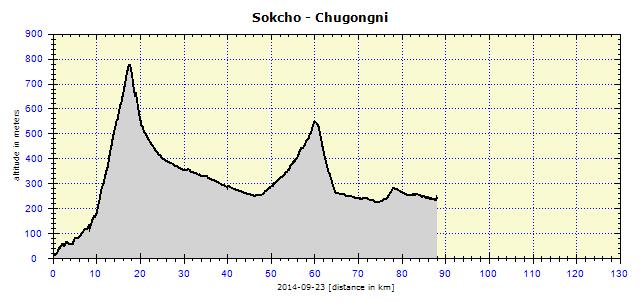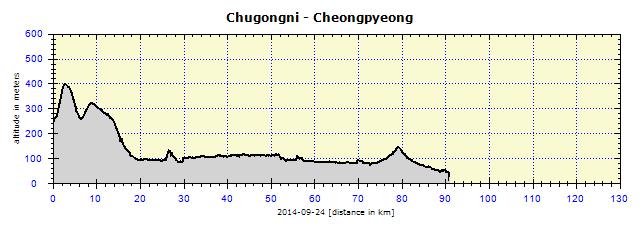
Nothing compares to the simple pleasure of a bike ride. J.F.Kennedy
Search this website
Across Korea
Sokcho, Wontong, Yongha, Chuncheon, Gapyeong, Paldang, Soul, Incheon
Seoraksan National Park
My journey along the East coast ended in Sokcho. First I had to visit the Seoraksan National Park, located conveniently only 13 km from the city. There was no campsite in the Park, but one was located about 6 km from the entrance gate. It was possible to camp at specified sites in the Park, but these spots could only be reached by half a day's hike over hill and dale. Impossible with a bicycle. So I chose the option for lazybones: accommodation in the center of Sokcho and travel to the Park by local public transport for a modest one-way fare of 22 CZK ($1). Entry fee to the Park was 70 CZK ($3,5), free of charge for seniors over 65 years. I wanted to exert my rights, but that option was available only to Koreans. This would not be possible in our country – we fear not being politically correct by discriminating against our fellow EU citizens.
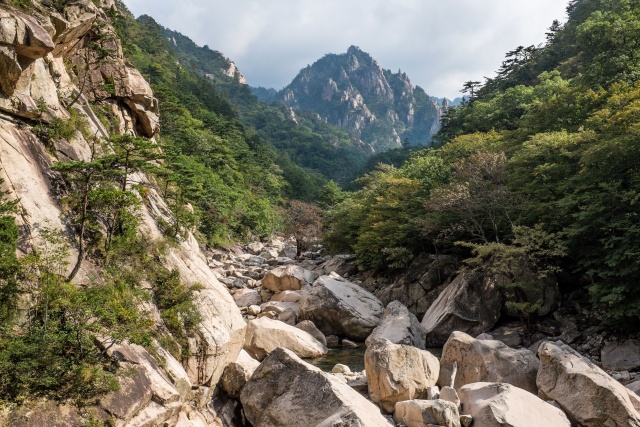
Seoraksan National Park: Valley below Biseondae rock
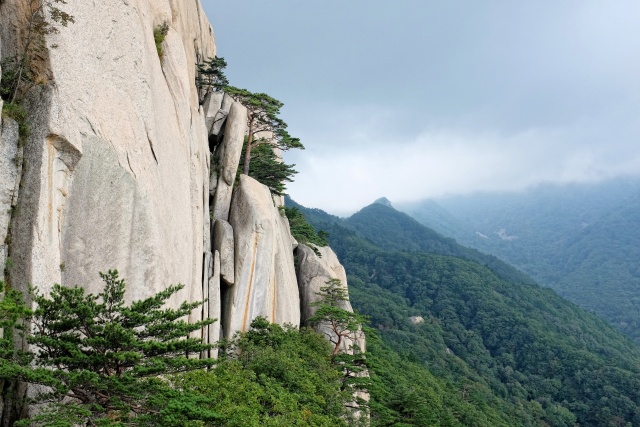
Seoraksan National Park: Ascent to Ulsanbawi – the rock wall is almost vertical in some places
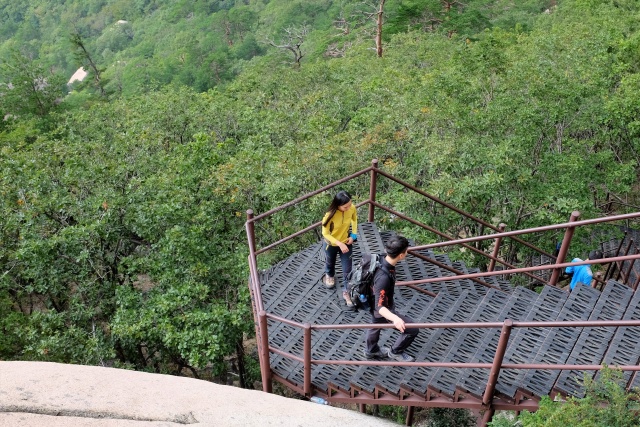
Seoraksan National Park: Ascent to Ulsanbawi – fortunately there are steps in the steepest upper part
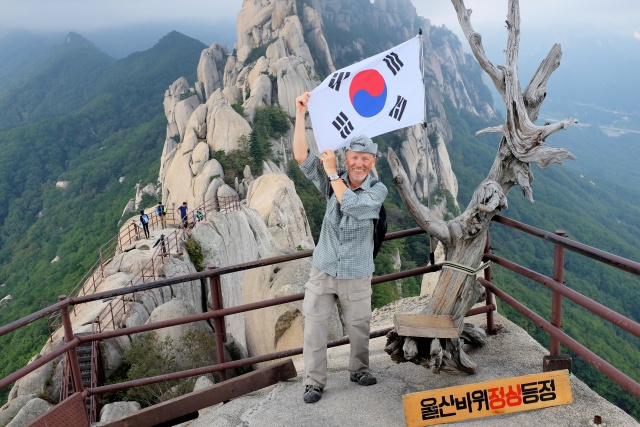
Seoraksan National Park: Ascent to Ulsanbawi – photo from the summit, I left the bike below
In the bus I met two young German and Dutch guys and we started to hike the Ulsanbawi Rock together. Before starting, I joked that the hike was to that rock 'over there' and we laughed about this. It turned out I was right and the hike turned out to be up to an elevation of 700 meters. The steepest part of the hike was several hundred meters on wide wooden steps. This is quite typical there and is due to the enormous number of tourists. During the steep ascent, these young boys fell behind, as they could not cope with the five times faster old grandpa. I greeted them again, when I met them once again about 300 meters from the summit, on my way down and they were still on their way up. From the top of the rock, I saw the road I would be cycling on the following day. The main road had a tunnel through which cyclists were not allowed, so I would have the pleasure of a hilly road again.
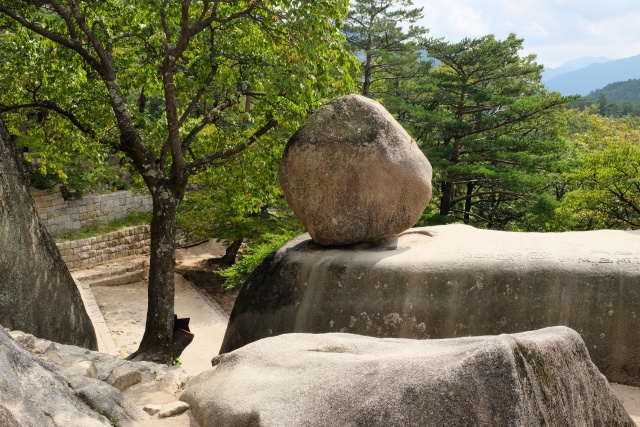
Seoraksan National Park: Rocking stone in front of Kyejoam Seokgul hermitage
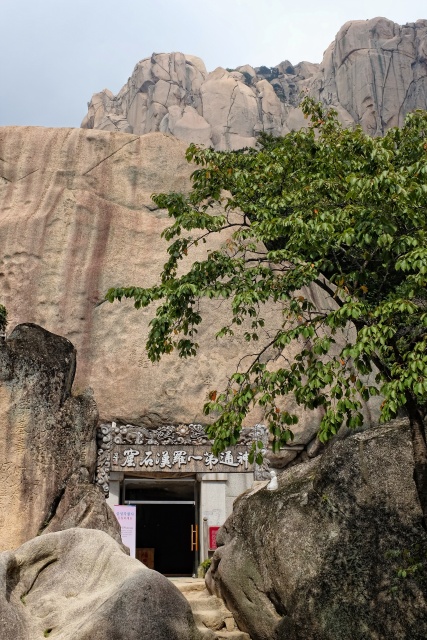
Seoraksan National Park: Entrance to Kyejoam Seokgul hermitage
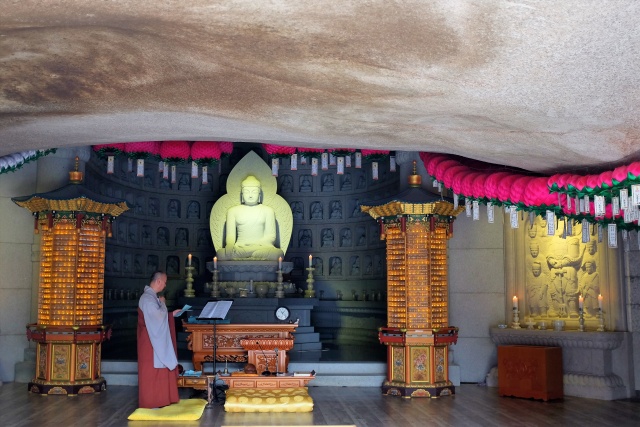
Seoraksan National Park: Interior of Kyejoam Seokgul hermitage
The next sites of interest, apart from beautiful and unspoilt Nature, were the local temples. One of them was carved into a rock, another was attractively situated in the surrounding countryside. Next to the third one was a 13-meter high bronze Buddha. My mind was filled with impressions.
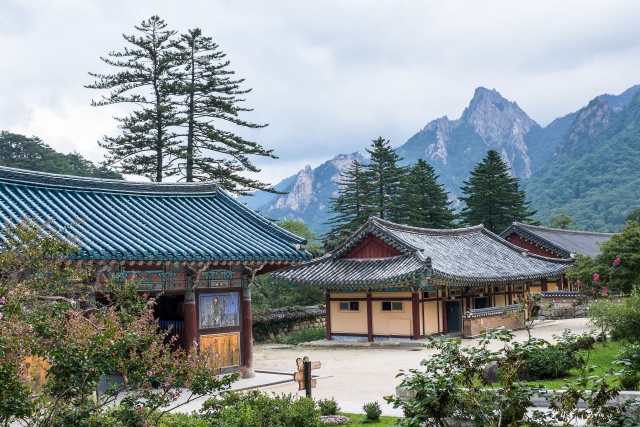
Seoraksan National Park: Shin Hung Sa Kukrakbojeon monastery is beautifully incorporated into the landscape
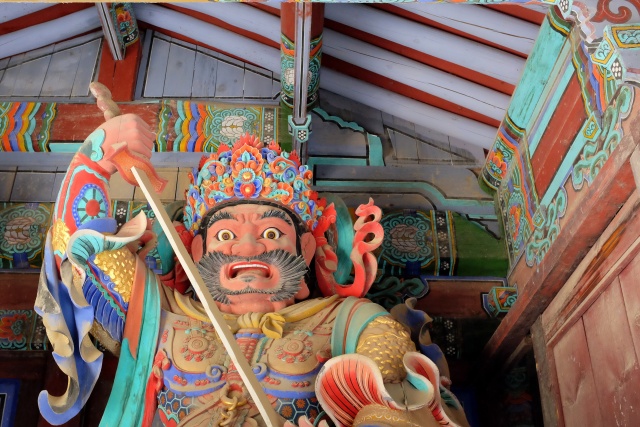
Seoraksan National Park: Shin Hung Sa Kukrakbojeon – guard at entrance gate
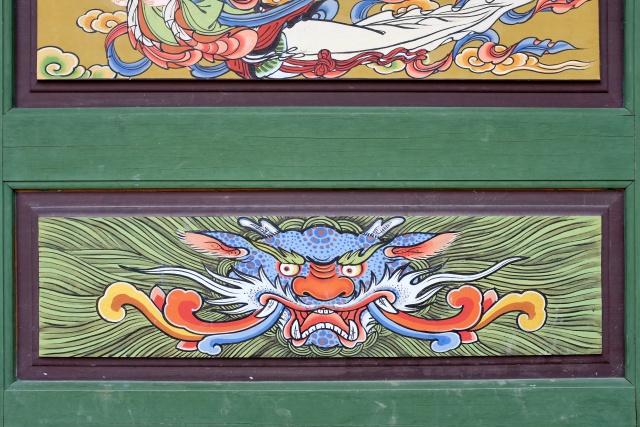
Seoraksan National Park: Shin Hung Sa Kukrakbojeon monastery – detail of exterior decoration
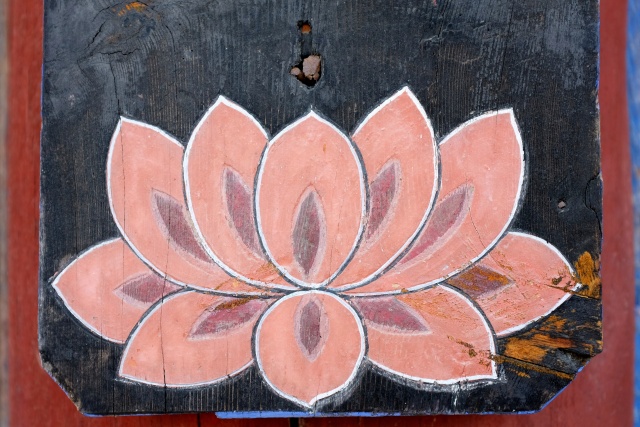
Seoraksan National Park: Shin Hung Sa Kukrakbojeon monastery – detail of exterior decoration
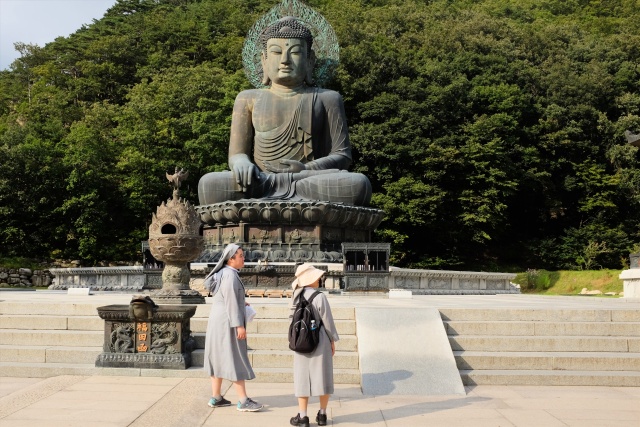
Seoraksan National Park: The Buddha at the Shinheungsa Temple is 13 meters high
Finally, here are some photos of several local 'sherpas', who carry food and drink up to the otherwise unavailable mountain cottages, carry down the trash and sometimes carry away even part of the damaged pathway.
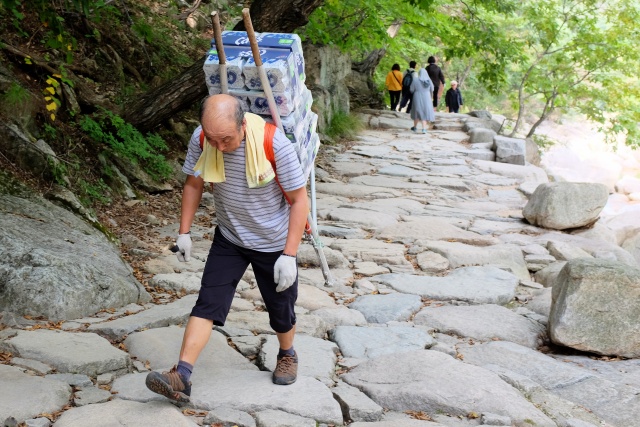
Seoraksan National Park: Porter
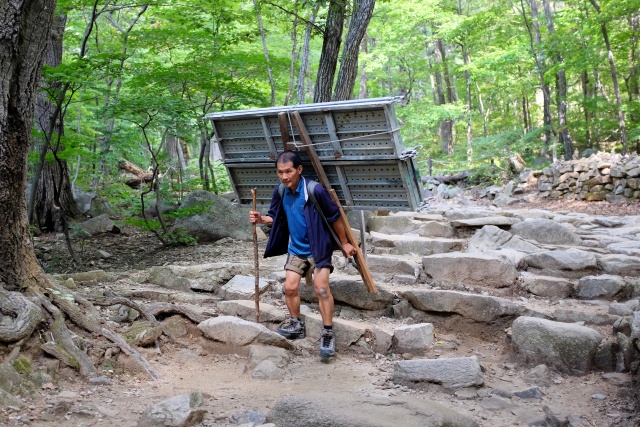
Seoraksan National Park: Carrier
In the Saddle Again
I made a beginner's mistake. I knew a heavy climb awaited me at the start of the day, yet I stuffed myself full at breakfast. The hostel provided a continental breakfast; I supplemented it with ramen (noodle soup), a whole cucumber, some cherry tomatoes and a large yogurt. I noticed all of these when cycling with difficulty out on the road. Cars could use the tunnel for a fee, cyclists were not allowed through it. I had to pedal uphill, at times there were very steep ascents to altitude almost 800 meters. At the beginning of the ascent, the bicycle produced a strange sound. I thought one of the spokes on the back wheel had broken. I was right about it being a wire, but it was a wire stuck in the tire. After a little while, it became apparent that the inner part of the tire had been penetrated. I had never had punctures, after starting to use Schwalbe Marathon tires. This was already the second time in Korea and for the same reason – objects stuck in the tire. It would have been great if they cleaned the side lanes every now and then.
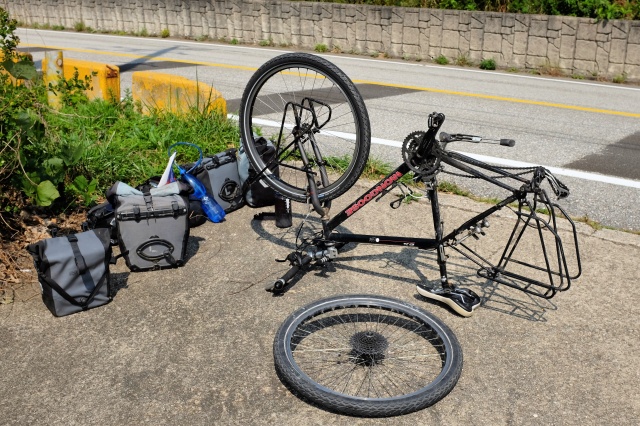
10 km W of Sokcho: I repair the second flat tire already on this trip – very peculiar
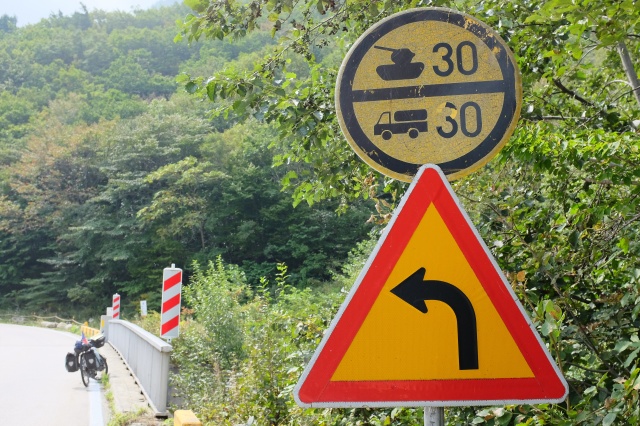
15 km W of Sokcho: An old sign
I totally sweated through my newly washed clothes. Nevertheless, I daringly pedaled up the hill and did not push the bicycle for even a millimeter. I reached the same elevation as the day before when I had hiked on Ulsanwabi, which was then covered in clouds. After a steep downhill, I entered a road reminiscent of a highway. The sign system was well organized – if there was an option of a side road, then the 'main road' forbade bicycles and signs diverted them to the side road with less traffic.
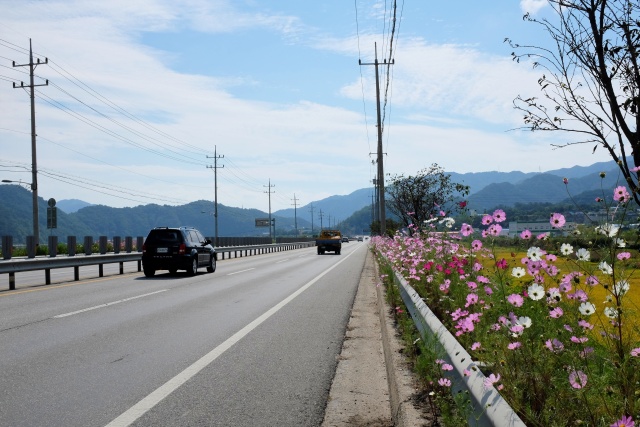
Wontong: Road decorated with planted meadow flowers
Then the flat terrain was replaced by another hill climb, although very persistent, it was only a mild incline. The first tunnel was 1700 meters long. Soldiers were swarming all around it. I was worried that a second Korean War had started. A marching convoy of about two kilometers in length even passed me coming from the opposite direction. All were young boys, simply cannon fodder. I remembered my military days and, with the knowledge that these were allies, I straightened up in the saddle and proudly saluted them. Many saluted back and it was apparent who took me seriously and who understood that I was joking.
In Yong Ha I could not find any open restaurant other than a stupid fast food outlet with Korean - style burgers, it was called something like "Mom's Touch". I tried one of them, but was still hungry. It was getting late, I cycled through a series of tunnels, the longest one was 3 km long. Not at all pleasant, stressful noise, something like a side lane was only 40 cm wide with big sewage drain covers. In the case of one of the grilles being missing, it would have been a huge problem. The front wheel would have fallen into it all the way to its center. I had to watch out for these and concentrate hard on cycling, with very little deviation from my path. It was getting late, dusk was approaching and I was searching for a place to stay. As always, it worked out in the end. After the exit of the last tunnel, an abandoned complex of buildings appeared in sight, with outside faucets with running water. There was even a forgotten pail, so I repeatedly splashed myself with cold water and it felt great. I pitched my tent in a huge wooden pavilion and cooked some beans with a local version of conserved ham, which is sold in the Czech Republic under the name of "luncheon meat".

Chugongni: I camped overnight in this huge pavilion
I woke up in the rain and was happy that I had pitched my tent under a roof and that everything was dry. I quickly packed up my tent. In the event of the owner turning up, it would look as if I'd only found quick cover from the rain there. I could have started already at 07:00, but it was raining heavily and persistently. I waited until 08:30 and then resolutely put on my waterproof clothes and got going. The road started with quite a steep 10 % ascent (usually marked on the signs), yet it was not that long, just enough to warm me up. This was followed by the first 2 km tunnel, with a 5 km one right after it. That one was the worst – especially the narrow side lane covered with gravel. It was quite a steep downhill, so I could not just freewheel, but had to brake constantly. You must understand, if I was cycling at 20 km per hour, I would have been in that tunnel for a whole 15 minutes. Really stressful! The only positive thing was that it did not rain in tunnels. Although, I noticed that in the valley, where the tunnel let me out, the rain was even heavier than in the previous one. And, after all, there was one more advantage: all the tunnels were either flat or downhill! If I'd been cycling in the opposite direction, the time spent in them would have rapidly been extended.
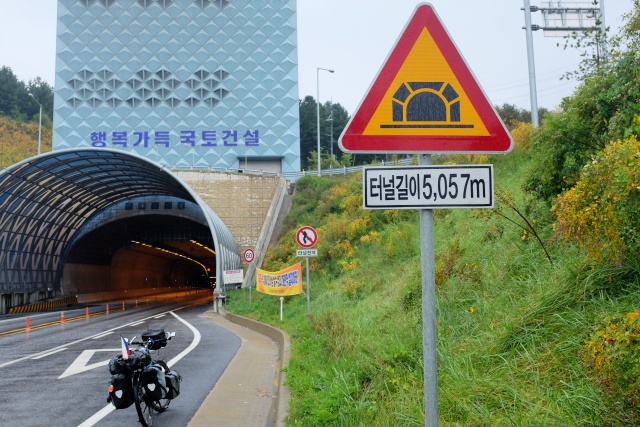
W of Chugongni: The longest tunnel was over 5 km long
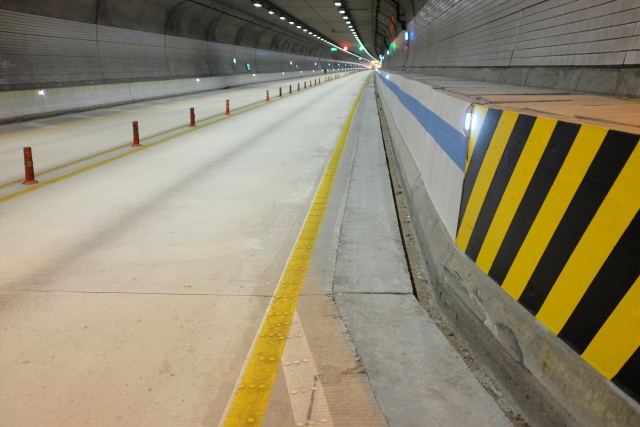
W of Chugongni: The space for cyclists in this tunnel is between the yellow line with reflectors and the water drain.
Chuncheon
I experienced problems with navigation. Road 46 led on to a highway, where bicycles are not allowed and the original road was closed for construction work. I went through the roadworks, entered a local road and gradually fought my way all the way to Chuncheon. Why did I go to Chuncheon, when it was much easier to reach Seoul from Sokcho (with less of an incline)? Well, I wanted to use the bike path along the Bukhan River, which would easily take me to Seoul, without having to share the route with cars. I reached Chuncheon Station, where this path started, and almost decided to stay in the city until the next day and wait out the persistently heavy rain.
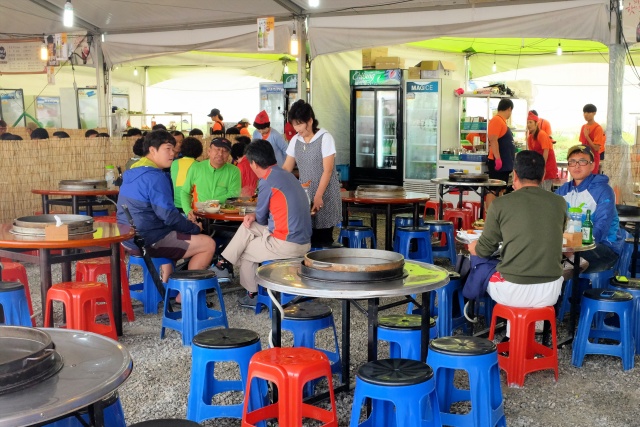
Chuncheon: There was an international food festival in the city, including 10 tent restaurants serving exclusively the local specialty of dakgalbi
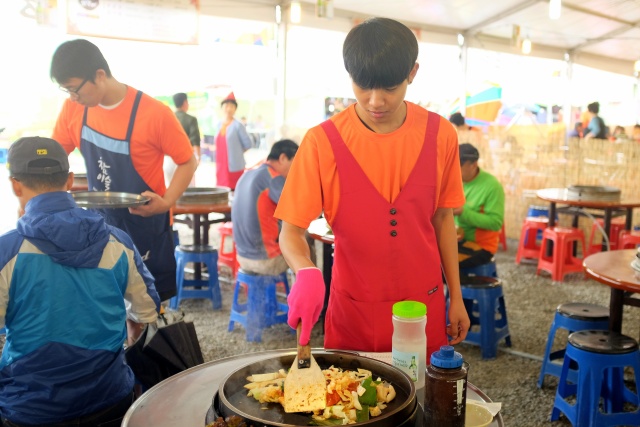
Chuncheon: The waiter preparing my first dakgalbi
At that time, the city was holding a festival of international food. I was more interested in the national food – but in all honesty, in any food – I was as hungry as a wolf! The festival was held in the center, over a wide area right opposite the Station. The inviting smells took me all the way to the center of the happenings: kebab, souvlaki and curry – these I could taste another time anywhere else. I aimed for the local specialty of dakgalbi, which is pieces of marinated chicken with vegetables and various other ingredients. They throw it all raw into a round pan built into the table and light the fire. The waiter prepares the food for less experienced customers like myself. He mixes the ingredients with a wide wooden spatula, stirring them until ready to be eaten. After this energy boost, I no longer insisted on staying over in Chuncheon and started my way on the bike path towards Seoul.
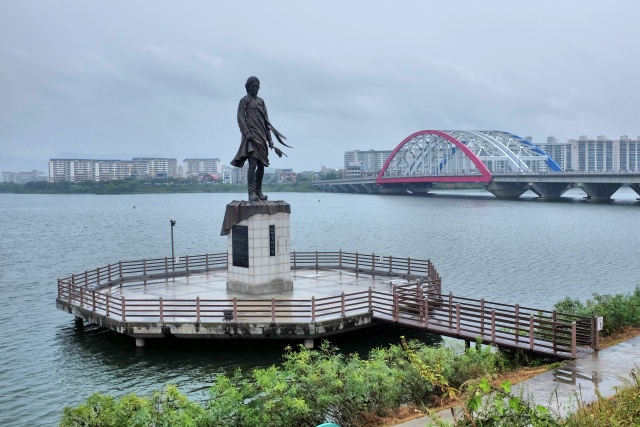
Chuncheon: Girl statue in Chuncheon Lake
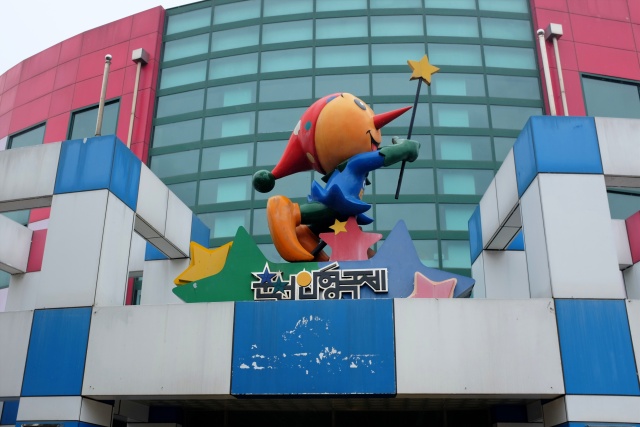
Chuncheon: Puppet theater known for its annual great festival
Bike Path along the Bukhan River
It was a great relief to be able to stop watching out for all the cars and only to enjoy the scenery. On the bike path, which leads in the hilly terrain, are separate tunnels for cyclists only. I truly enjoyed those. I repeated the dakgalbi experience in Gangchon. This time I had the know-how and ruled the spatula myself. Towards evening, I started looking out for possible places to sleep. I stopped at a campsite on the path, but resisted giving them 400 CZK ($20) for the night. The advantage of the bike path is that one can cycle right until sunset, so I decided to delay finding a place as for as long as possible. When it became almost impossible to see, I made my bed in a neglected park next to the river. There were some platforms with cloth tents, but no running water or toilets.
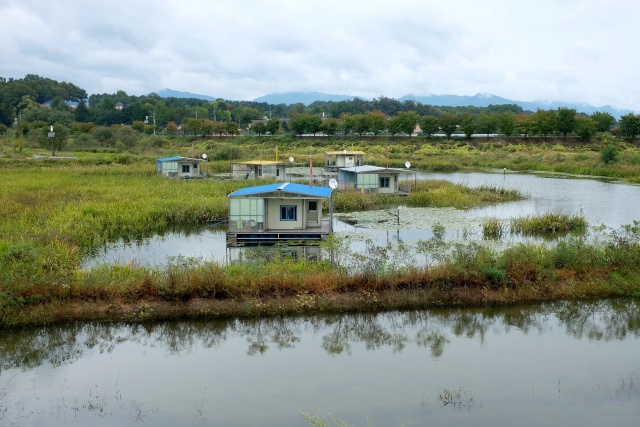
Geumsan: The cottage people didn't die out, here are cottages on small pontoons everywhere
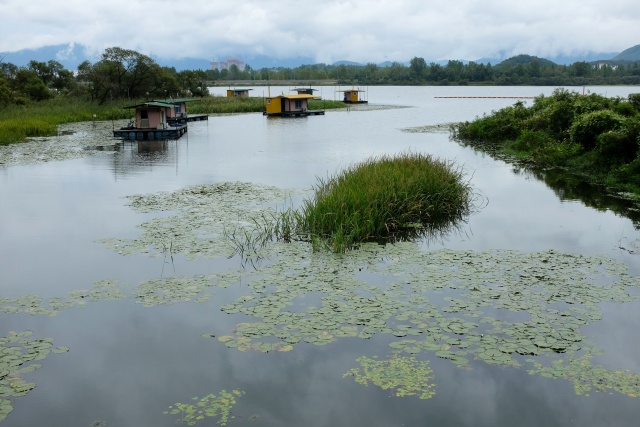
Hyeonam: More ”cottagers” in these delightful backwaters
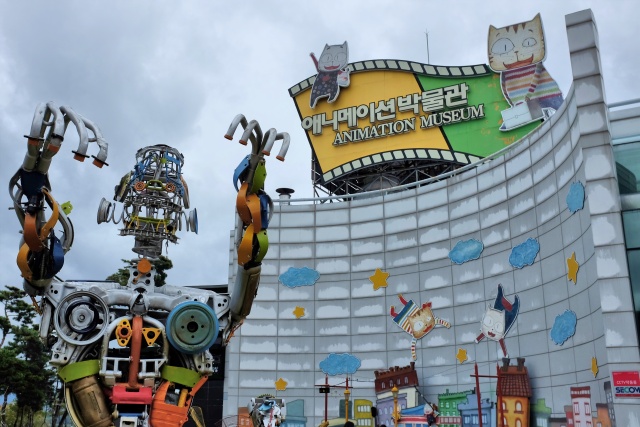
Geumsan: Animation Museum
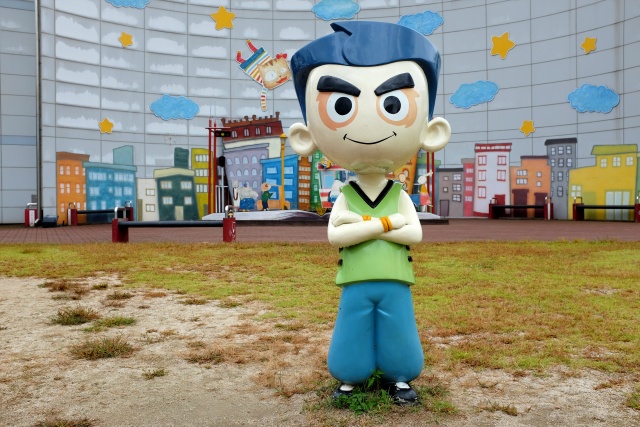
Geumsan: Animation Museum
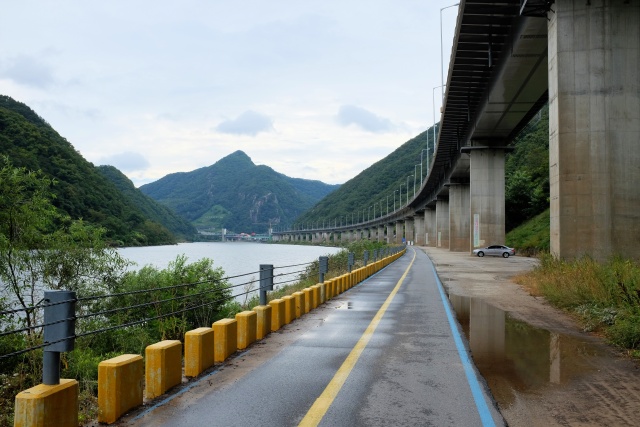
Gangchon: The bike path runs alongside the original road and the new road is up on the ramp
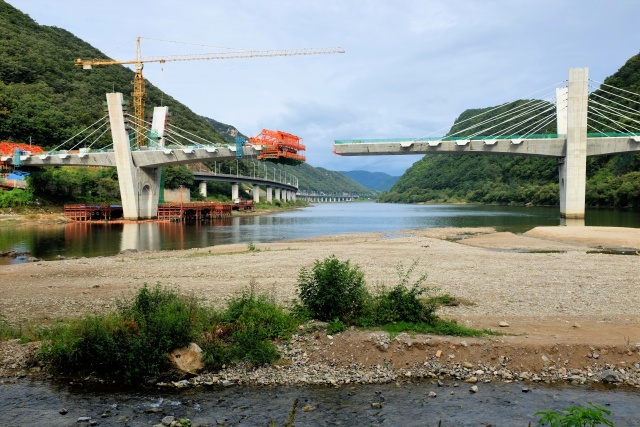
Gangchon: Another bridge across Bukhan River being built 100 m from the present bridge
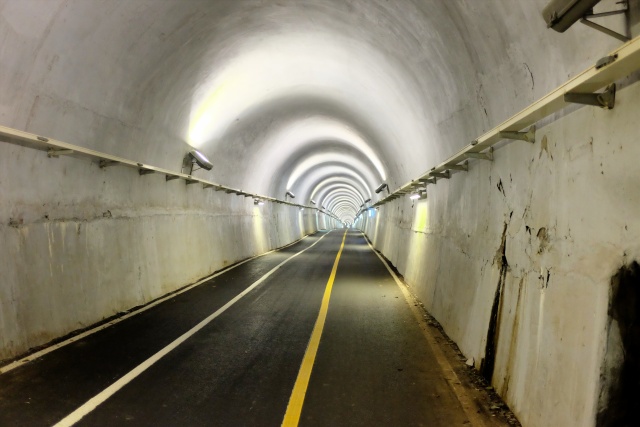
Daeseong: 600 m long bicycle tunnel, what a fantastic ride, and furthermore it was downhill
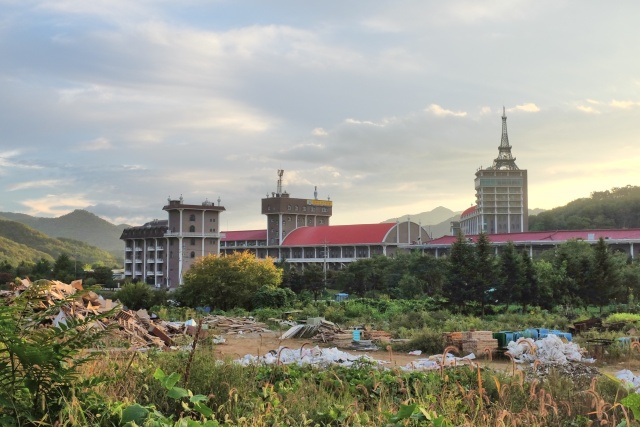
Cheopyeong: Motels try to advertise themselves e.g. with a rooftop Eiffel Tower
The following morning, just like the evening before, I cleaned myself with baby's moist wet wipes. It is strange I had never come up with this idea myself before, until Alain Ricard taught it to me during my travels the previous year in Newfoundland. After about 5 km I came across the ideal spot with running water and benches. I washed and made breakfast. Apparently the breakfast was not adequate, as I stopped at the first mandu stall and, as their first customer, ate well and even took some away as supplies.
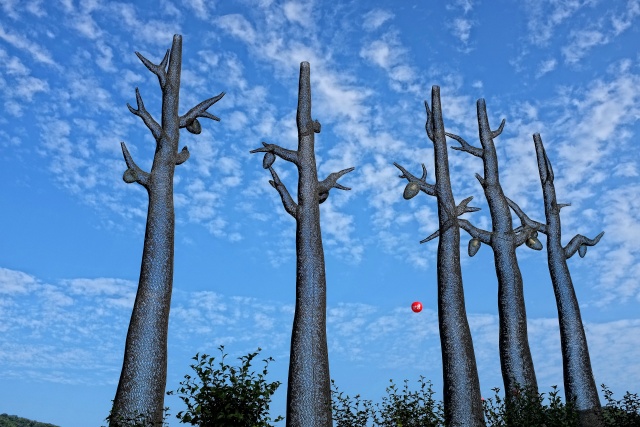
W of Cheopyeong: Apart from the clouds, everything is definitely man-made
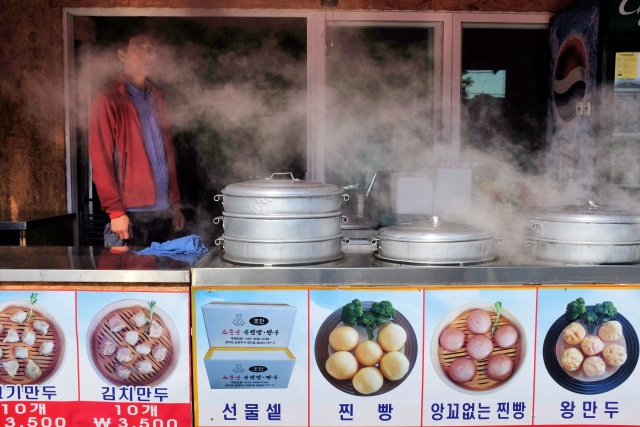
W of Cheopyeong: At the dumpling stand I react like Pavlov's dogs, eating one portion on the spot and taking another away
The number of cyclists increased, many were interested from where and to where I was going. I shared some of my visiting cards. Then I figured that I had been there long enough and started on the path along the Han River to Seoul. I had already taken this path on August 31, but in the opposite direction.
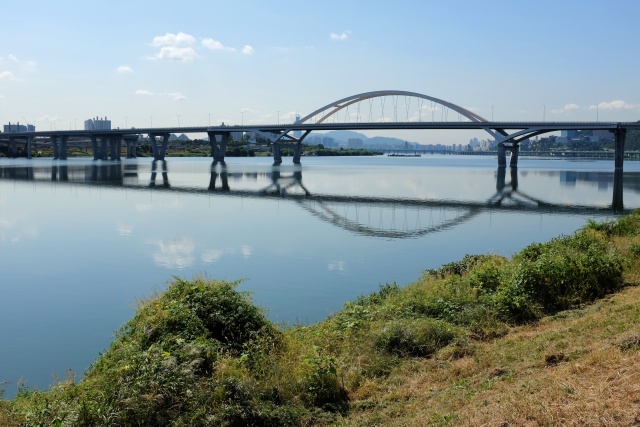
Deokso: The first bridge over Han River with a view of Seoul in the distance
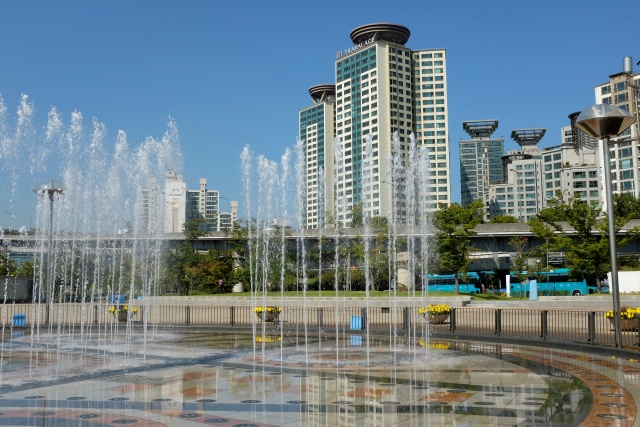
Ttukseom Observation Complex: Musical fountain – we know it from Julda Fulda (old public recreational park in Prague)
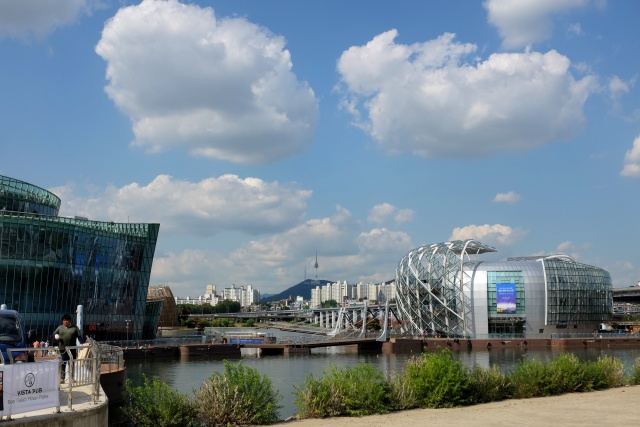
Banpo - Hangang Park: Futuristic buildings, Seoul Tower in the background
Ride through Seoul
Very easy ride on flat surface, tip-top cycle paths, all well marked. I arrived at the end of the Hangang cycle trail and connected to the cycle trail along the Ara Canal, which took me to the coast of the China Sea and to Incheon. I pitched my tent in Geomam Park; three other much bigger tents were already pitched there. I left all my bags on the bike, took out the laptop and, on a bench with a bottle of local beer, tried to put together my experiences. Suddenly a uniformed guard turned up on his bicycle, showed me his identification, saying he was from K-Water and started speaking in an unfriendly tone. I only managed to get out: "good evening" and that was enough for him to change his tune. "I am sorry, you are not Korean? I am sorry, are you staying over here until Monday?" It was Thursday, so I assured him I would be leaving the following morning. He insisted that it would not be necessary and that I could stay until the Monday. Then he stopped next to me one more time and, with a bow, said goodbye. I was puzzled by this; he did not even stop at the bigger tents. Then I figured it out. Korean homeless people, as well as their Japanese comrades, usually have their bicycles loaded with all their belongings (not in Ortlieb bags, but in plastic bags). The guards were there to ensure problem-free camping for "decent" people.
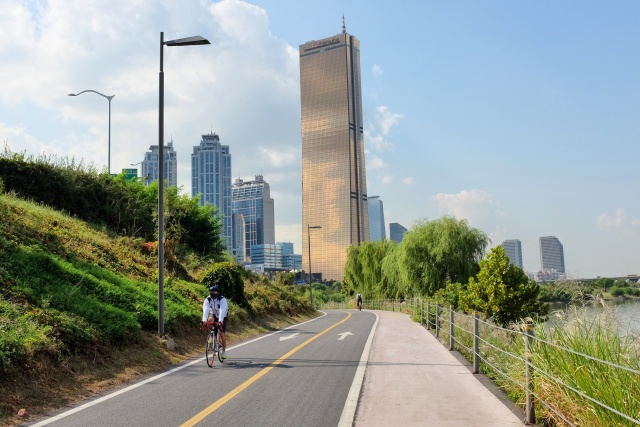
Yeouido - Hangang Park: The bike path runs directly below impressive skyscrapers
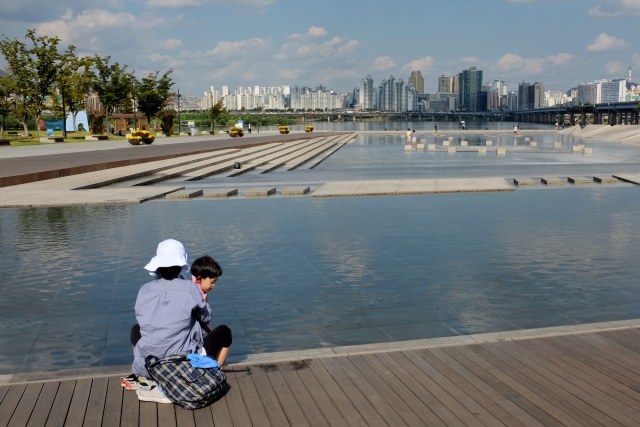
Yeouido - Hangang Park: Shallow padding pool for the pleasure of both old and young
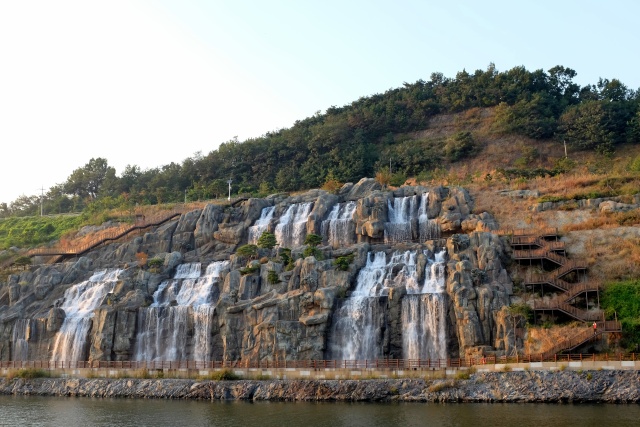
Ara Falls: Waterfalls on the opposite side of the Ara water canal
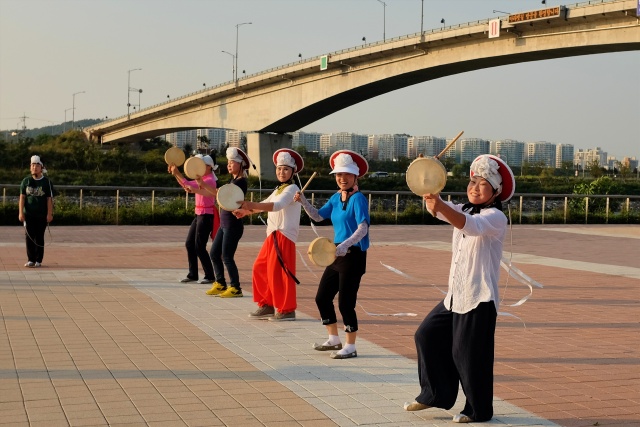
Duri Park: A group practicing folk dance in an open space
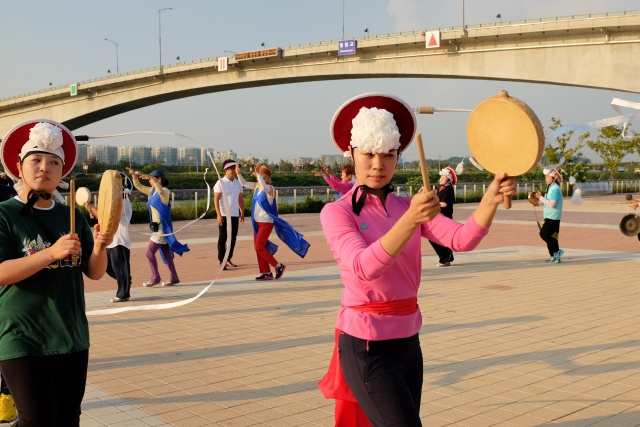
Duri Park: One of the dancers
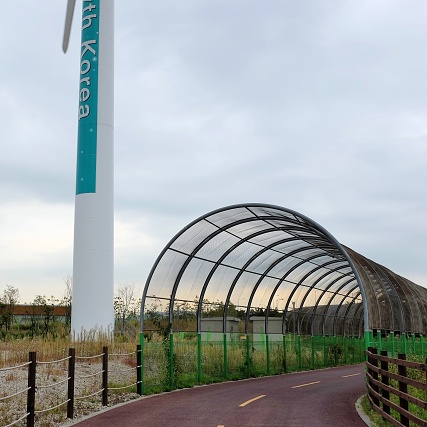
Incheon: Below the wind turbine rotors, the bike path is covered by a net to protect cyclists from falling birds
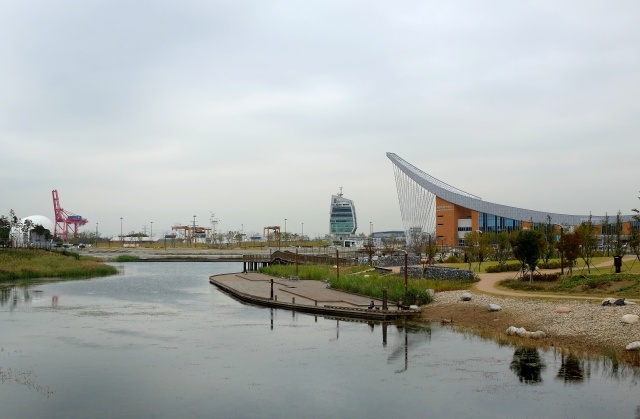
Incheon: Ara bike path ends in a not too inviting area
Incheon
The cycle trail along the Ara Canal ends on the outskirts of Incheon. The truth is – in the not very attractive environment of a logistics terminal. I did not cook in the morning, only had a wash in the nearby bathroom and followed my GPS to Incheon center. The most interesting part was in the Chinatown vicinity, so I headed directly to its center. Due to heavy traffic, I rode on the sidewalks, where the bike paths varied in quality. I ate brunch in a supermarket and, by lunch time, had already opened the door to the first motel in Chinatown. The owner wanted 40 000 Won from 16:00; if I wanted immediate accommodation, it would be 50 000 Won. I pressed on to the center and instantly found accommodation for 40 000 Won. Strategic position, 500 meters to Chinatown, 500 meters to the city center, 500 meters to a big supermarket.

Incheon: In front of the Chinese-Korean Cultural Center
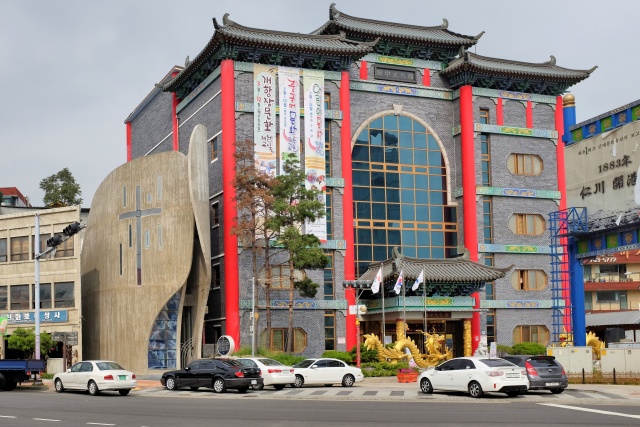
Incheon: Christian church glued on to Chinese-Korean Cultural Center
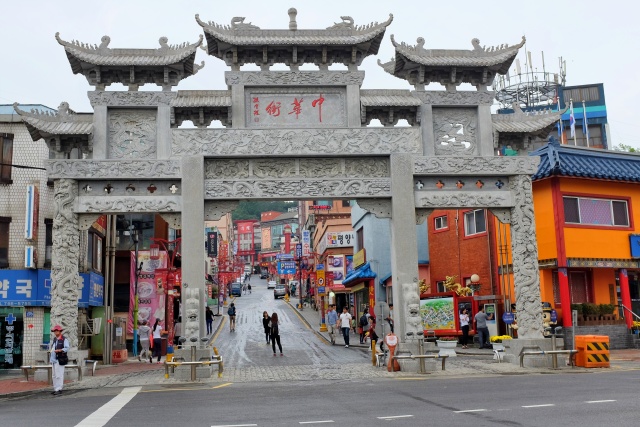
Incheon: Pailoul Jungwagal – one of the gates of Chinatown
I did not waste a minute, did my laundry and went out to see the city. I had already oriented myself on arrival, so I knew in which direction to go. First to pick up a map in an Info Center, then to Wolmido Island where a park in classical Korean garden style was located together with a several memorials of the famous landing of General MacArthur. At the beginning of the Korean War, the communist occupied the entire Korea, except the perimeter around Pusan (today Busan). MacArthur realized that the communists must have logistical problems. So he moored his ship in Incheon, with minimal losses blocked the North Korean supply routes and got South Korea back from the 38th Parallel. He remains a hero in Incheon to this day. In Jayu Park there is a 5-meter high statue to him, dressed in his battle dress and with binoculars in his hand. However, the Chinese entered this conflict on the side of communist Korea. The arduous war lasting nearly three years with many casualties did not decide anything and Korea remains divided at the 38th Parallel (in reality, the border between the countries is several km north of the 38th Parallel).
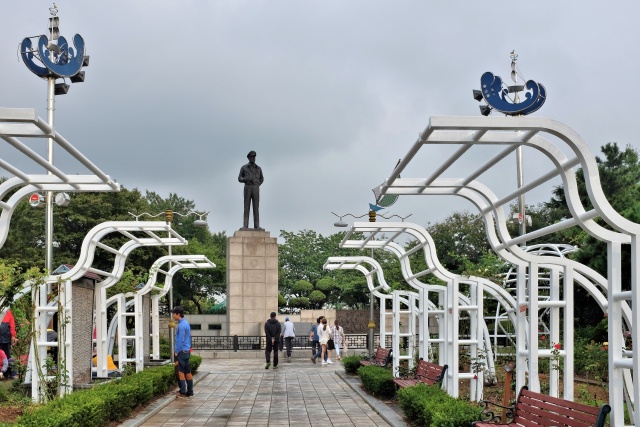
Incheon: Statue of General Douglas MacArthur – Incheon's number 1 hero
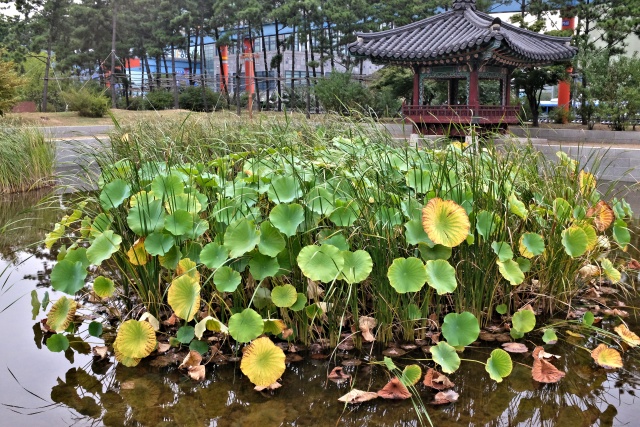
Incheon: Wolmido Island – bower in a classic Korean garden
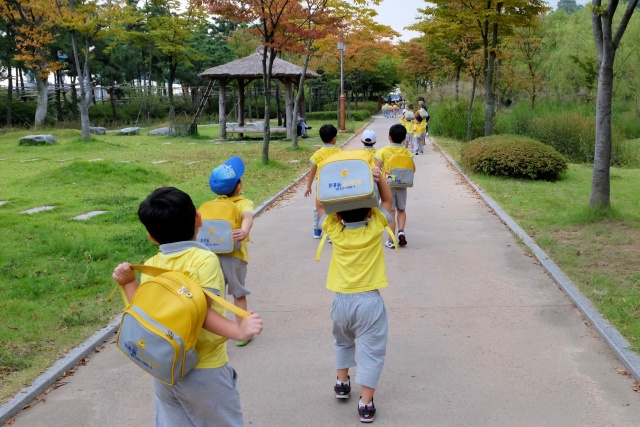
Incheon: Wolmido Island – kindergarten class on an excursion
It started raining so heavily that I rapidly had to end my island exploration. I had a rainproof jacket, but the pants had seen better days. A big broken umbrella, which did not stay open, was lying next to the road. I removed the strap from the handle, strapped it around the canopy of the umbrella and happily marched back to Chinatown. At times when the rain eased off, I only released the strap and folded up the umbrella. When it looked like it had finally stopped raining, I placed the umbrella behind a big billboard, maybe it would be of use again the following day.
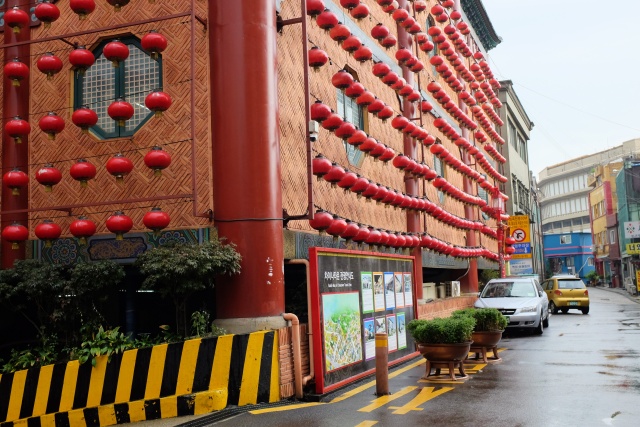
Incheon: Chinatown
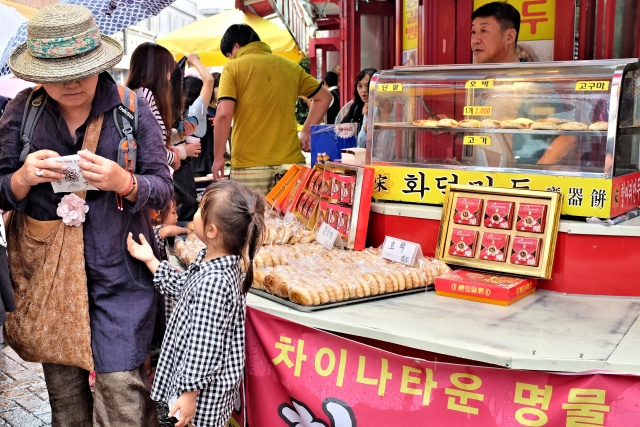
Incheon: Chinese sweet stall
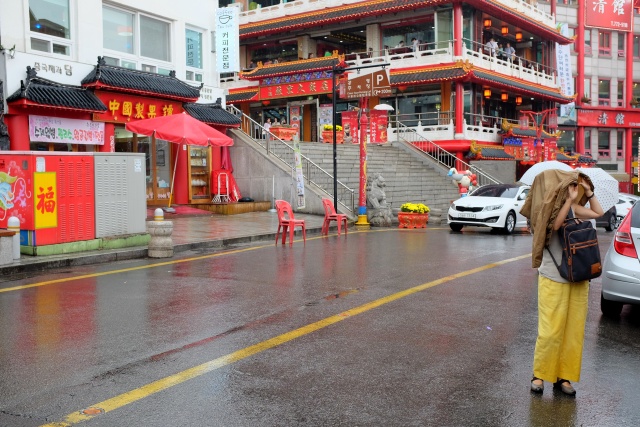
Incheon: Any protection is good in the rain
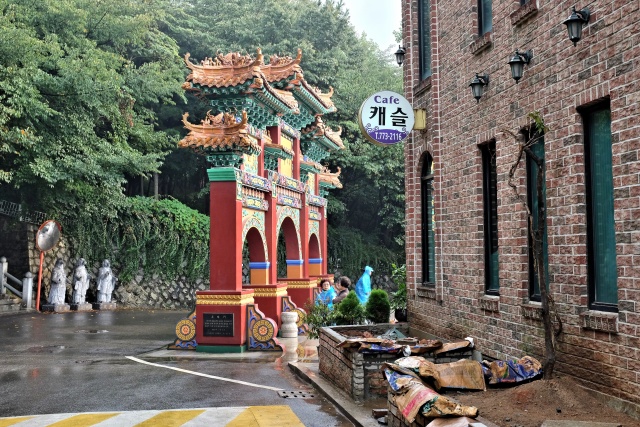
Incheon: The gate that separates Chinatown from Jayu Park
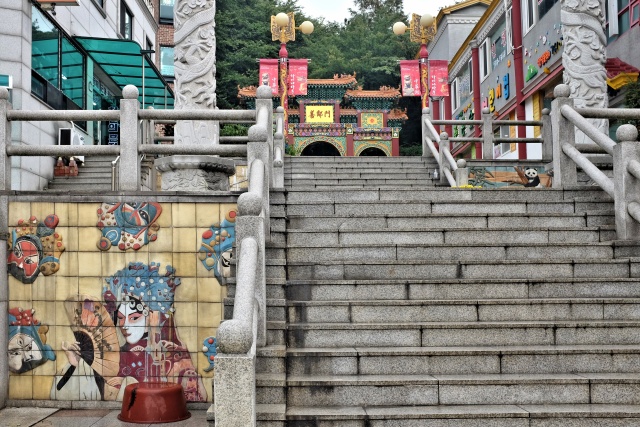
Incheon: Chinatown
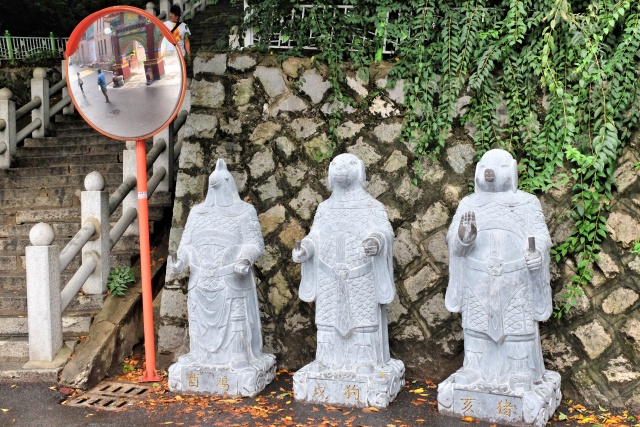
Incheon: Statues depicting signs of the Chinese horoscope – I am the pig on the right
Chinatown is entertaining, picturesque, fragrant as well as smelly, depending on how one looks at it. I was mainly attracted by the restaurants specializing in Chinese filled dumplings, which did not much differ – either in appearance or taste – from Korean mandu. Naturally, I had them for dinner, and in Incheon for the first time it was possible to season them with both soya sauce and vinegar. I found this tastier. The proximity to the sea and the international harbor had the advantage of also providing menus in English and with prices in Arabic figures, not only in Korean symbols, as I had mostly found in the countryside.
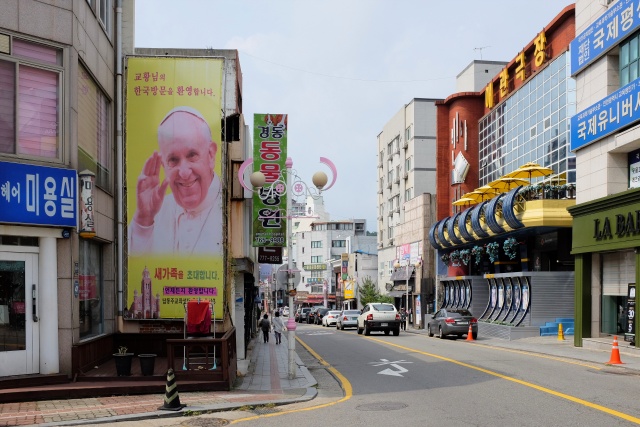
Incheon: Reminder of previous year's Papal visit
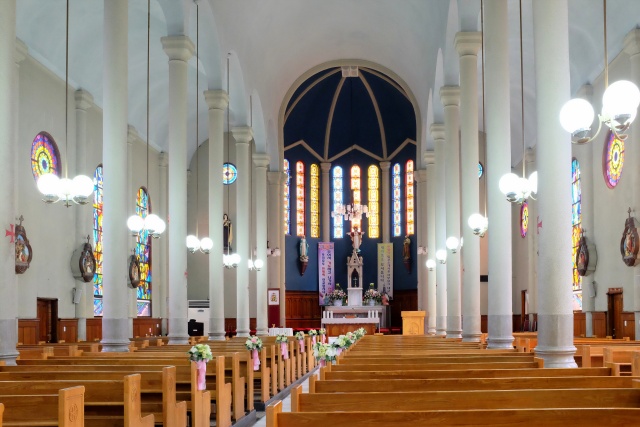
Incheon: Interior of Catholic Cathedral

Incheon: The bride was already waiting for the groom in the chamber
I found out that the following two days there would be a Festival of Culture and Tourism in Jayu Park. I decided to stay for one more day. I took it easy the following morning, cooked a proper breakfast, strolled through the center, tasted various dishes from various grannies on the market, without endangering my digestive system. The Catholic Cathedral, which the Pope had visited in September, was preparing for a wedding. The bride was standing by herself in a small chapel. With her agreement, I took a photo of her and wished her "good luck". I also had to spend some time in a pub, in order to survive this cultural overload.
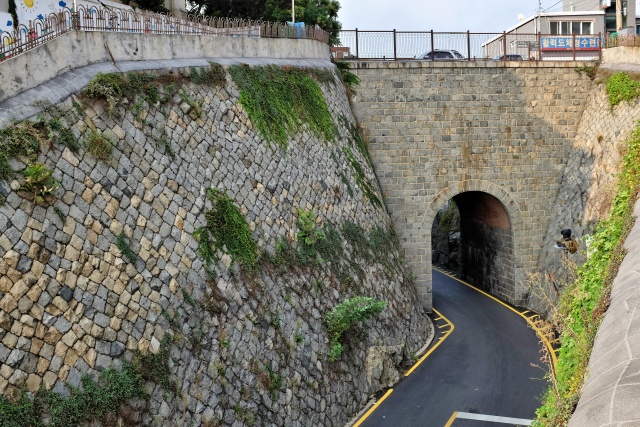
Incheon: Hongyemun gate
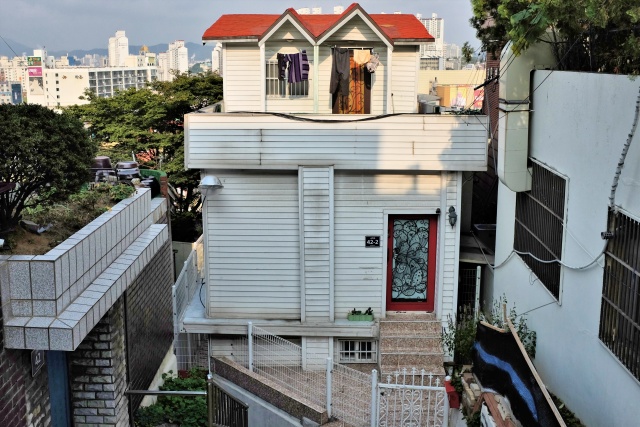
Incheon: Squeezed-in house
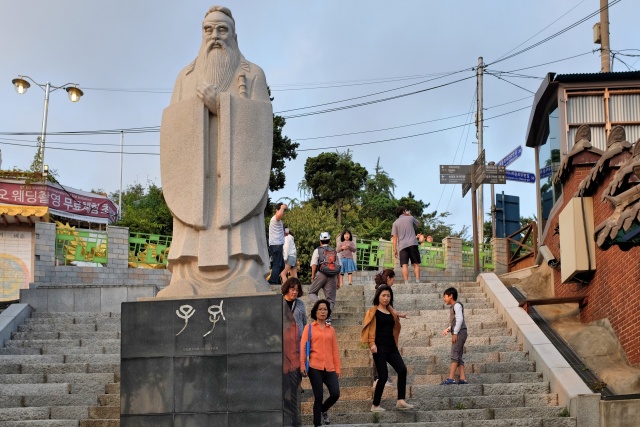
Incheon: Confucius statue
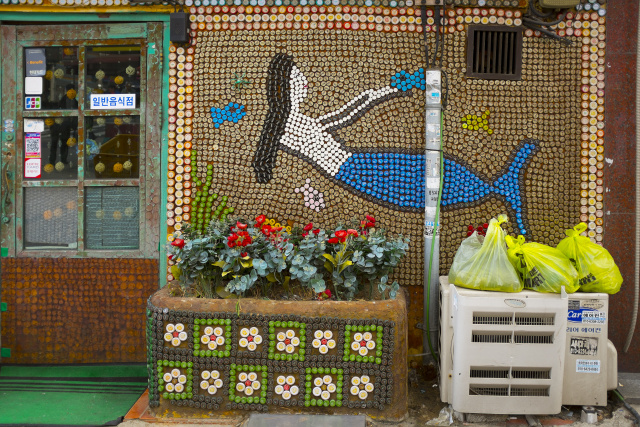
Incheon: Mosaic decoration
Cultural Tourism Festival
The program was of a quality varying from total failures to quite good items. It started at 16:00 with folklore. Then two women tried to sing – that was a total failure. Then a five-member boy band came on stage and performed a breakdance in Gangnam style. Amazing show. Then wild men in folk costume with rotating ribbons on their hats tried to compete with the breakdancers, and together they created a super show of radically different styles of, in reality, the same dance.
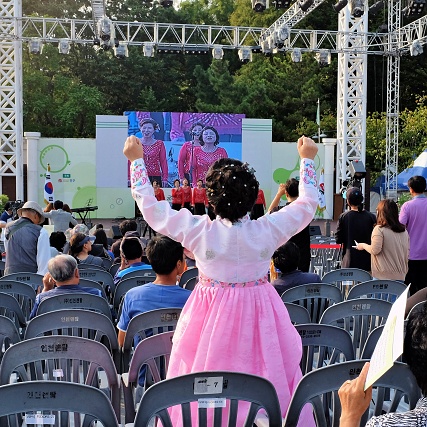
Incheon: Cultural Festival – conductress conducts her singing sheep from the audience
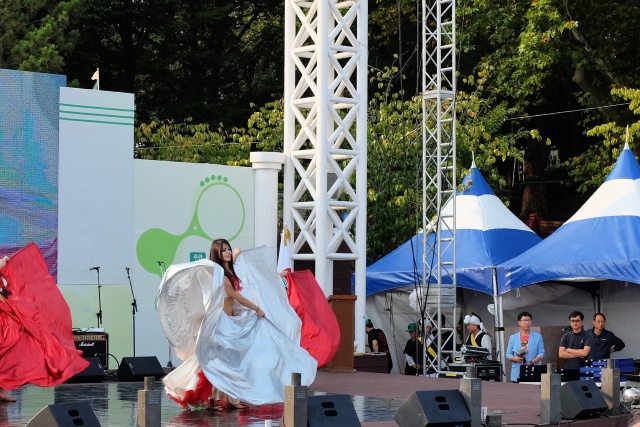
Incheon: Cultural Festival – girls with swirling skirts
The show was interrupted by the official opening of the event. The numerous local dignitaries sat in a separate section. The national anthem was played, followed by a commemoration of war victims. Then they named all the dignitaries in the first and second row. These stood up, bowing to all the cardinal points. The physiognomy was interesting – the faces of dignitaries are really the same all around the world. They occupied a total of 6 rows, each of about 50 people. After the second row, they speeded up in the reading of the names until they were gabbling. It was hilarious. I walked to the local bar, to wait out the officialities. I surprisingly got to like it there and returned to the festival at 19:00.
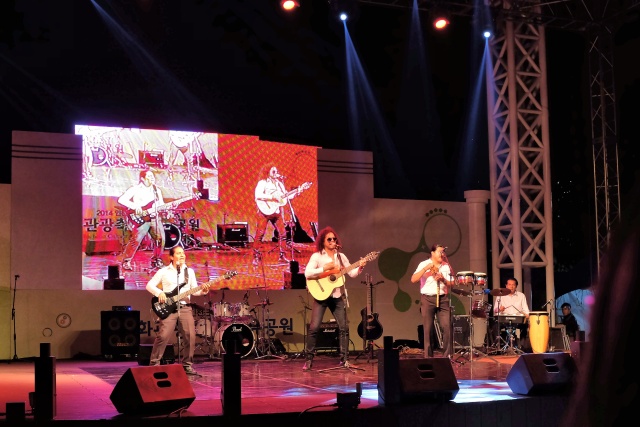
Incheon: Cultural Festival – Mexican amigos
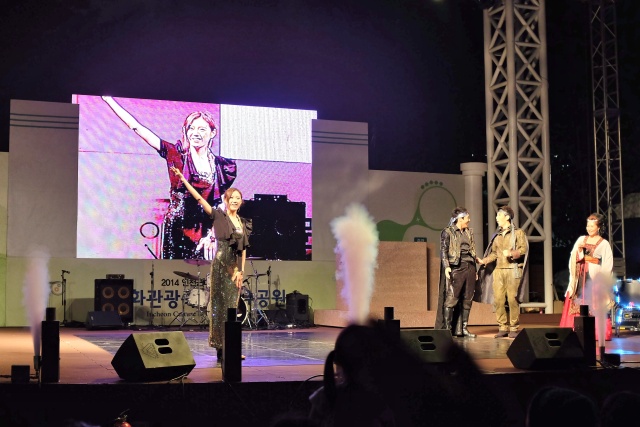
Incheon: Cultural Festival – series on Korean history
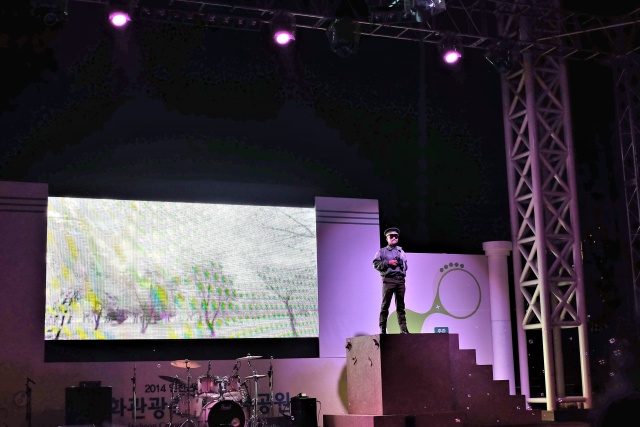
Incheon: Cultural Festival – General MacArthur reaped applause on the open stage
There was pop, great jazz, a Mexican group at the end – not so great. Then a 20-minute Gangnam disco, followed by scenes enacted from Korean history. The Japanese were portrayed as the worst of all people, Americans as saviors and, when MacArthur turned up, he received as frenetic a welcome as if he had stepped down from the nearby monument. That's how it was.
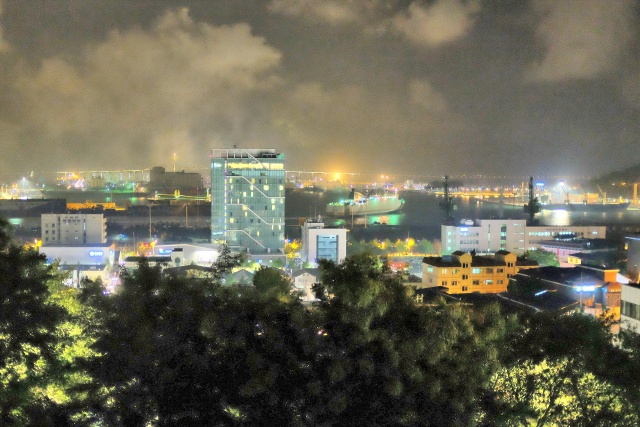
Incheon: City and harbor by night
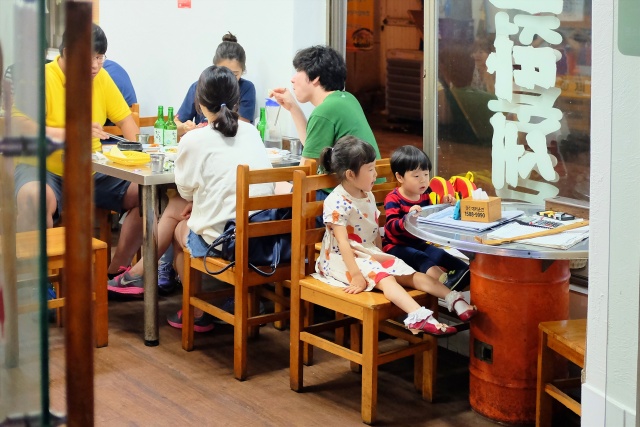
Incheon: Parents are partying, but it's no longer fun for the kids, so they find a tablet
